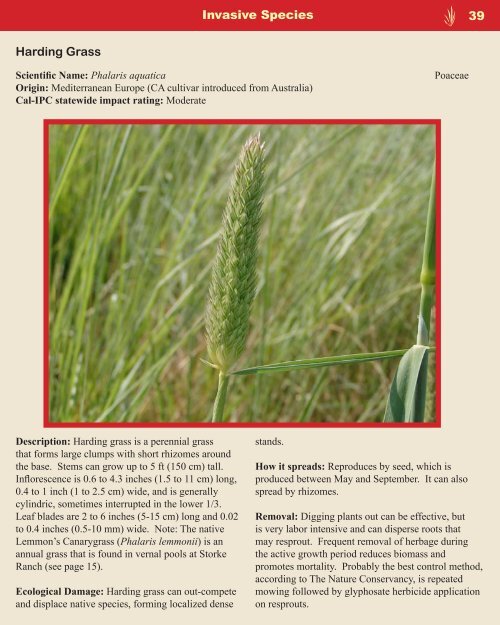Guide to Native and Invasive Plants Storke Ranch Vernal ... - Cram
Guide to Native and Invasive Plants Storke Ranch Vernal ... - Cram
Guide to Native and Invasive Plants Storke Ranch Vernal ... - Cram
You also want an ePaper? Increase the reach of your titles
YUMPU automatically turns print PDFs into web optimized ePapers that Google loves.
<strong>Invasive</strong> Species 39<br />
Harding Grass<br />
Scientific Name: Phalaris aquatica<br />
Origin: Mediterranean Europe (CA cultivar introduced from Australia)<br />
Cal-IPC statewide impact rating: Moderate<br />
Poaceae<br />
Description: Harding grass is a perennial grass<br />
that forms large clumps with short rhizomes around<br />
the base. Stems can grow up <strong>to</strong> 5 ft (150 cm) tall.<br />
Inflorescence is 0.6 <strong>to</strong> 4.3 inches (1.5 <strong>to</strong> 11 cm) long,<br />
0.4 <strong>to</strong> 1 inch (1 <strong>to</strong> 2.5 cm) wide, <strong>and</strong> is generally<br />
cylindric, sometimes interrupted in the lower 1/3.<br />
Leaf blades are 2 <strong>to</strong> 6 inches (5-15 cm) long <strong>and</strong> 0.02<br />
<strong>to</strong> 0.4 inches (0.5-10 mm) wide. Note: The native<br />
Lemmon’s Canarygrass (Phalaris lemmonii) is an<br />
annual grass that is found in vernal pools at S<strong>to</strong>rke<br />
<strong>Ranch</strong> (see page 15).<br />
Ecological Damage: Harding grass can out-compete<br />
<strong>and</strong> displace native species, forming localized dense<br />
st<strong>and</strong>s.<br />
How it spreads: Reproduces by seed, which is<br />
produced between May <strong>and</strong> September. It can also<br />
spread by rhizomes.<br />
Removal: Digging plants out can be effective, but<br />
is very labor intensive <strong>and</strong> can disperse roots that<br />
may resprout. Frequent removal of herbage during<br />
the active growth period reduces biomass <strong>and</strong><br />
promotes mortality. Probably the best control method,<br />
according <strong>to</strong> The Nature Conservancy, is repeated<br />
mowing followed by glyphosate herbicide application<br />
on resprouts.















